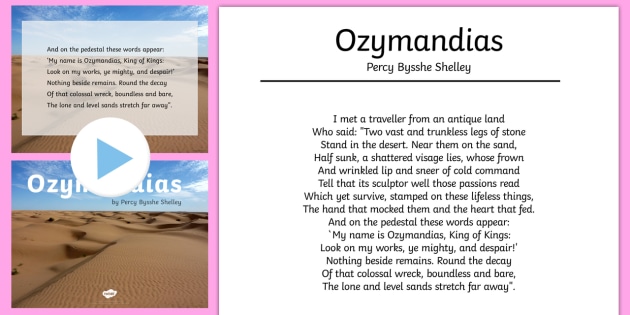

Look on my works, ye Mighty, and despair!” That’s why his passions or works still survive and shows that his people still remember him, even though he is dead. (line 8), this imagery demonstrate that the statue who was once a powerful man who used to be wicked, but takes good care of his people. “The hand that mock’d them and the heart that fed” This shows that the sculptor who designs the statue might have known the man who represents the statue, because he did a great job of designing it. “Tell that its sculptor well those passions read which yet survive”(line 6-7). To continue, Shelly uses more imagery to talk about this random statue, the traveler sees in the desert. The hand that mock’d them and the heart that fed. Which yet survive, stamp’d on these lifeless things, Tell that its sculptor well those passions read Thompson appears to have been the first to point this out – that is, in reference to “Ozymandias” (Mozer). “Of course, according to some scholars all such efforts to excavate the face of Shelley’s pharaoh from the ruins of Egypt are categorically futile because ancient Egyptian statuary did not depict the pharaohs with features like “frown,” “wrinkled lip,” or “sneer.” D.W. “Cold command”, might mean that he can still rule people even though his face is separate from his body.

This imagery is so vivid that we can actually see that the statue was mad about something because his face was frowning. Shelly wrote “whose frown and winkled lip and sneer of cold command” (line 4-5). In this line, the imagery “Visage” referred to a face, which means that the head of the statue is buried in the sand near the rest the remaining pieces of the body. “Near them on the san, half sunk, a shattered visages lies” (line 4). The symbol of “trunckles legs” shows that the statue has ruins and only the big two hands remain and the body disappeared completely. In these lines the traveler starts to tell his story about what he saw. “Who said: two vast and truckles legs of stone” (line 2). Shelly continued to talk about what the traveler told him. He wrote “antique land,” this imagery shows that he meet the traveler from a desert or an unknown place because the word “antique” means ancient, old. To begin, in the first line Shelly uses imagery to describe where he met the traveler who will told the story. Half sunk, a shatter’d visage lies, whose frownĪnd wrinkled lip and sneer of cold command Who said: Two vast and trunkless legs of stone In these two poems both poets use imagery, metaphor, symbol and irony to explain how possession and beauty are temporary. The poems have same themes similarity “Ozymandias” talks about a statue portray as a king, who was a powerful leader and lost it all and ruined, while “Sonnet 18” talks about a woman beauty are compared to nature and how her beauty fades away as time goes by. In the poem “Ozymandias” by Percy Bysshe Shelley and “Sonnet 18” by William Shakespeare, each poet does a great job on writing a fourteen line poem talk about how possession and beauty can be gone so quickly. Everything in this world can change in a matter of second.


 0 kommentar(er)
0 kommentar(er)
